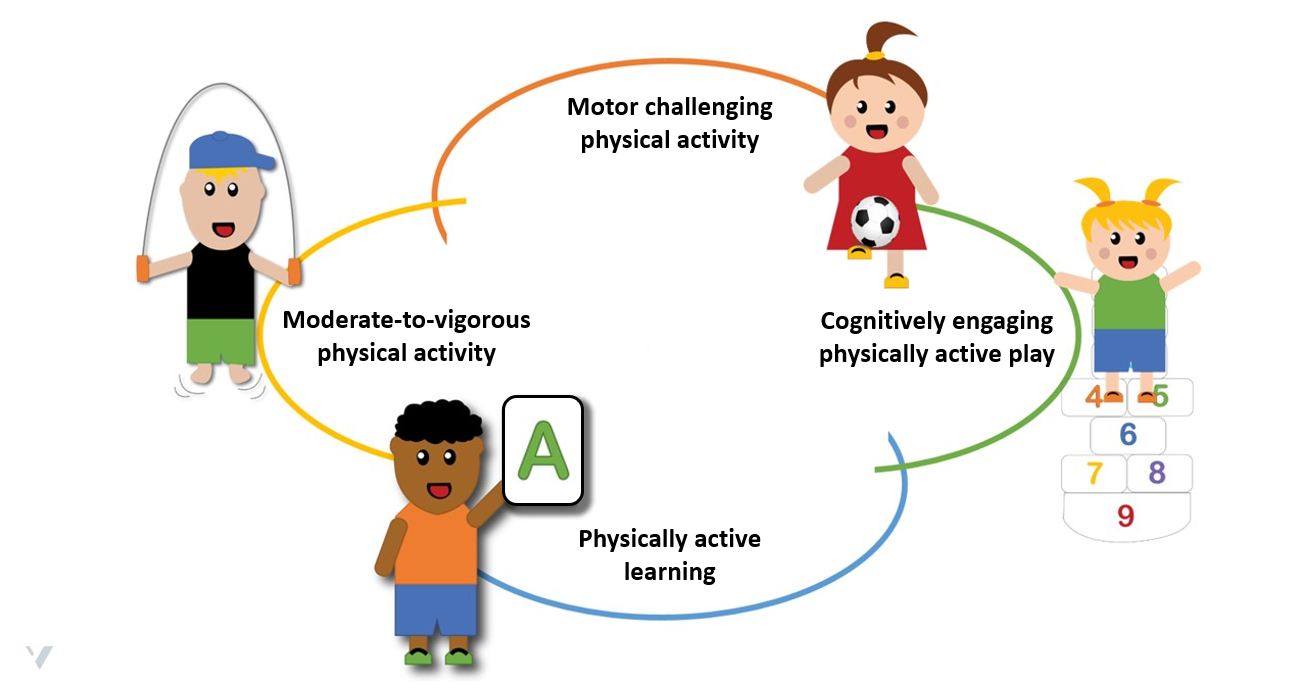Here you find a description of different types of physical activity with different qualities. When different types of physical activities are promoted, you can impact several areas of child development, for example, physical development, cognitive development, learning and socioemotional development. The four types of physical activity described below are intertwined (as the figure demonstrates), and often the activities are of both moderate to vigorous intensity, they challenge motor skills, and are cognitively engaging at the same time. For instance, when playing Chain Tag in the forest, the children run fast, their motor skills are challenged by running on uneven terrain, and at the same time they are cognitively engaged in order to tag or to avoid being tagged by other children. Four short video clips describing four different types of physical activity are found below.

Moderate-to-vigorous physical activity
Activities of moderate to vigorous intensity significantly increase a child’s energy consumption. In other words, such activities make children breathe heavier, warm and tired. Examples are gross motor activities involving the large muscle groups , such as running, jumping and hopping. When carrying out activities that increase energy consumption, the muscles need more nutrients and oxygen. This leads to a range of positive effects on the muscles, the heart and the respiratory system, but also the nervous system and the Activities of moderate to vigorous intensity significantly increase a child’s energy consumption. In other words, such activities make children breathe heavier, warm and tired. Examples are gross motor activities involving the large muscle groups , such as running, jumping and hopping. When carrying out activities that increase energy consumption, the muscles need more nutrients and oxygen. This leads to a range of positive effects on the muscles, the heart and the respiratory system, but also the nervous system and the brain. The activities can be performed indoors and outdoors, and can be organised in many different ways with great variation. International physical activity guidelines (World Health Organisation) recommend at least 180 minutes per day of movement for children aged 1-5 years and that 60 minutes of this activity should be of moderate-to-vigorous intensity from the age of 3 years.
Motor challenging physical activity
Motor challenging physical activities refer to a range of activities that require children to challenge themselves and concentrate to complete the activity. Such activities enable children to learn new and more difficult movement patterns. Important motor skills refer to a range of gross motor movement patterns that are generally divided into three areas: locomotor skills, object control skills and balance skills. Activities that challenge locomotor skills include running, jumping, hopping, etc. Activities that challenge object control skills are throwing, kicking and catching, for example, a ball, bean bag, etc. Activities that challenge balance skills include walking on a line, standing on one foot, hopping, etc. Many movement patterns require good eye-hand and eye-foot coordination, and the different areas will also overlap in a range of complex activities and games, for example, football. Children learn new movement patterns by being challenged by increasing the difficulty level in known movement patterns or by introducing new movement patterns. In contrast to moderate-to-vigorous-intensity activities, where the intensity and quantity (how much) are important, the quality of the movement pattern is generally more important to create motor challenges.
Cognitively engaging physically active play
Cognitively engaging physically active play refer to games and activities that children find meaningful and engaging but are often complex to execute. Typical examples include different types of games with rules, chasing and catching games, and team games where children must act according to rules, co-players and opposing players. Such activities require that children remember information (rules). Children must act according to information acquired along the way, for example, what the others do, where they move, and what they should do in order to achieve the goal, to score or to catch someone. Rules can be varied to change the premises for the activity and thus make the game more challenging. Such activities place demands on children’s cognitive functioning, including remembering information, making choices, inhibition of planned movements, and being flexible and strategic. In this way, the activities can challenge children’s self-regulation in relation to movement and behaviour; planning and choices; and thoughts and emotions, thereby promoting both cognitive and socioemotional self-regulation.
Physically active learning
Physically active learning refers to physical activity connected to other subject areas in the curricula. The objective of the activity is two-fold, that is being more active through the preschool day without reducing the time spent on other content, whilst at the same time promoting learning through embodiment and concretisation of the focused content. In addition, being physically activity while working on curricula may increase the ability to concentrate. In this way, physically activity learning is a play and learning method that can be used when working with other activities, for example, linked to language development, understanding numbers, space and shape or knowledge about nature. Some activities can be performed parallel to other learning activities (without being integrated in the learning objective), for example, by using relay races in combination with the learning of words/concepts, where running is not directly connected to the words/concepts to be learned. Other activities can be integrated with other learning objectives, for example, by shaping the body into letters and numbers, jumping or hopping with a specific number of repetitions to learn a number sequence or by measuring and raising awareness about quantity/volume and space by using the body. Physically active learning could be a good way to make learning in preschools more playful, meaningful and fun.

